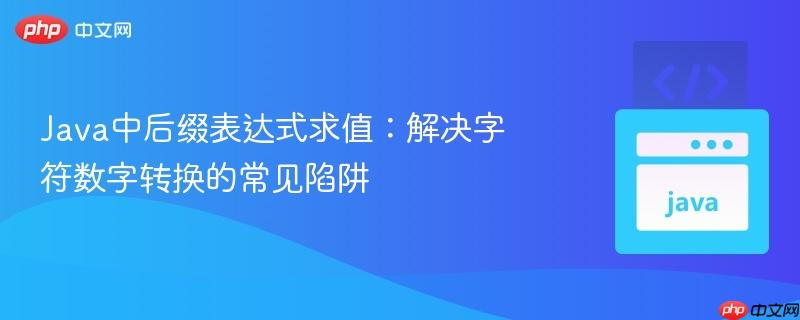
本文深入探讨了在java中使用栈实现后缀表达式求值时,字符数字转换的常见错误。通过分析将字符直接转换为浮点数导致的问题,教程提供了`char - '0'`的解决方案,并给出了修正后的代码示例,确保求值结果的准确性。
后缀表达式(也称为逆波兰表示法)是一种没有括号的算术表达式,其操作符位于操作数之后。例如,中缀表达式 (3 + 1) * 2 对应的后缀表达式是 3 1 + 2 *。后缀表达式的求值通常利用栈数据结构进行:遇到操作数就入栈,遇到操作符就从栈中弹出相应数量的操作数进行计算,然后将结果重新入栈。
在实现后缀表达式求值时,一个常见的错误是将表达式字符串中的数字字符直接转换为其数值。例如,当从字符串中读取字符 '3' 时,如果直接将其强制转换为 float 或 int,Java 会将其视为其 ASCII 值(对于 '3' 来说是 51),而非数字 3。这会导致计算结果严重偏离预期。
考虑以下Java代码片段,它尝试实现后缀表达式求值:
import java.util.Stack;
public class PostFixEvaluate {
// 计算方法
public static float calculate(Float operand_1, char operator, Float operand_2) {
switch (operator) {
case '+':
return operand_2 + operand_1;
case '-':
return operand_2 - operand_1;
case '*':
return operand_2 * operand_1;
case '/':
if (operand_1 == 0) { // 避免除以零
throw new ArithmeticException("Division by zero");
}
return operand_2 / operand_1;
}
return 0; // 默认值,实际应抛出异常
}
// 判断是否为操作数
public static boolean isOperand(char c) {
return !(c == '+' || c == '-' || c == '*' || c == '/');
}
// 后缀表达式求值主方法
public static float postFixEvaluation(String expr) {
Stack<Float> stack = new Stack<>();
int index = 0;
while (index < expr.length()) {
char token = expr.charAt(index);
if (isOperand(token)) { // 操作数
float operandIn = (float) token; // 错误点:直接将字符转换为float
stack.push(operandIn);
} else { // 操作符
if (stack.size() < 2) { // 检查操作数是否足够
throw new IllegalArgumentException("Invalid postfix expression: not enough operands for operator " + token);
}
float a = stack.pop(); // operand_1 (右操作数)
float b = stack.pop(); // operand_2 (左操作数)
stack.push(calculate(a, token, b));
}
index += 1;
}
if (stack.size() != 1) { // 表达式结束时栈中应只剩一个结果
throw new IllegalArgumentException("Invalid postfix expression: too many operands or operators");
}
return stack.pop();
}
// 主函数用于测试
public static void main(String[] args) {
String expr = "312*+456*+97-/+";
try {
float result = postFixEvaluation(expr);
System.out.println("Expression: " + expr);
System.out.println("Calculated Result: " + result); // 期望 22.0
} catch (Exception e) {
System.err.println("Error: " + e.getMessage());
}
}
}当输入表达式 312*+456*+97-/+ 时,期望结果为 22.0。然而,上述代码的输出却是 3958.0。问题出在 (float) token; 这一行。例如,当 token 是字符 '3' 时,operandIn 的值会是 51.0 (ASCII 值),而不是 3.0。
立即学习“Java免费学习笔记(深入)”;
要将字符数字(如 '0' 到 '9')转换为其对应的整数值,最常用的方法是减去字符 '0' 的 ASCII 值。在Java中,字符本质上是16位的无符号整数,表示Unicode字符。当对字符进行算术运算时,它们会被提升为 int 类型。
例如:
这个技巧利用了数字字符在ASCII/Unicode编码表中是连续排列的特性。
将 postFixEvaluation 方法中处理操作数的部分修改为:
if (isOperand(token)) { // 操作数
// 修正点:将字符数字转换为其对应的数值
float operandIn = (float) (token - '0');
stack.push(operandIn);
} import java.util.Stack;
public class PostFixEvaluate {
/**
* 执行基本的算术运算。
*
* @param operand_1 右操作数(先出栈)
* @param operator 运算符
* @param operand_2 左操作数(后出栈)
* @return 运算结果
* @throws ArithmeticException 如果发生除以零的情况
*/
public static float calculate(Float operand_1, char operator, Float operand_2) {
switch (operator) {
case '+':
return operand_2 + operand_1;
case '-':
return operand_2 - operand_1;
case '*':
return operand_2 * operand_1;
case '/':
if (operand_1 == 0) {
throw new ArithmeticException("Division by zero is not allowed.");
}
return operand_2 / operand_1;
default:
throw new IllegalArgumentException("Unknown operator: " + operator);
}
}
/**
* 判断给定字符是否为操作数。
*
* @param c 待判断字符
* @return 如果是操作数返回 true,否则返回 false (即为操作符)
*/
public static boolean isOperand(char c) {
// 使用Character.isDigit() 更通用,但根据原问题,仅考虑单字符数字
return Character.isDigit(c);
}
/**
* 对后缀表达式进行求值。
* 假设表达式中的数字都是单个数位。
*
* @param expr 后缀表达式字符串
* @return 表达式的计算结果
* @throws IllegalArgumentException 如果表达式无效(操作数不足、操作符未知、表达式格式错误)
* @throws ArithmeticException 如果计算中发生除以零
*/
public static float postFixEvaluation(String expr) {
Stack<Float> stack = new Stack<>();
int index = 0;
while (index < expr.length()) {
char token = expr.charAt(index);
if (isOperand(token)) { // 如果是操作数
// 关键修正:将字符数字转换为其对应的数值
float operandIn = (float) (token - '0');
stack.push(operandIn);
} else { // 如果是操作符
if (stack.size() < 2) {
throw new IllegalArgumentException("Invalid postfix expression: not enough operands for operator '" + token + "'");
}
float operand_1 = stack.pop(); // 右操作数
float operand_2 = stack.pop(); // 左操作数
stack.push(calculate(operand_2, token, operand_1)); // 注意calculate的参数顺序
}
index += 1;
}
if (stack.size() != 1) {
throw new IllegalArgumentException("Invalid postfix expression: malformed expression (stack size " + stack.size() + " after evaluation)");
}
return stack.pop();
}
public static void main(String[] args) {
String expr = "312*+456*+97-/+"; // 对应中缀表达式 (3 + (1 * 2)) + ((4 + (5 * 6)) / (9 - 7))
// = (3 + 2) + ((4 + 30) / 2)
// = 5 + (34 / 2)
// = 5 + 17
// = 22.0
try {
float result = postFixEvaluation(expr);
System.out.println("Expression: " + expr);
System.out.println("Calculated Result: " + result); // 期望 22.0
} catch (Exception e) {
System.err.println("Error evaluating expression: " + e.getMessage());
}
// 更多测试用例
try {
System.out.println("\nTesting '23+': " + postFixEvaluation("23+")); // Expected: 5.0
System.out.println("Testing '52-': " + postFixEvaluation("52-")); // Expected: 3.0
System.out.println("Testing '45*': " + postFixEvaluation("45*")); // Expected: 20.0
System.out.println("Testing '63/': " + postFixEvaluation("63/")); // Expected: 2.0
System.out.println("Testing '12+3*': " + postFixEvaluation("12+3*")); // Expected: 9.0
// System.out.println("Testing '50/': " + postFixEvaluation("50/")); // Should throw ArithmeticException
// System.out.println("Testing '2+': " + postFixEvaluation("2+")); // Should throw IllegalArgumentException
} catch (Exception e) {
System.err.println("Test Error: " + e.getMessage());
}
}
}通过理解字符与数字在Java中的表示差异,并采用 char - '0' 的转换技巧,可以有效解决后缀表达式求值中字符数字解析错误的问题。一个健壮的后缀表达式求值器还需要结合严谨的错误处理和对多位数、浮点数精度的考虑。
以上就是Java中后缀表达式求值:解决字符数字转换的常见陷阱的详细内容,更多请关注php中文网其它相关文章!

每个人都需要一台速度更快、更稳定的 PC。随着时间的推移,垃圾文件、旧注册表数据和不必要的后台进程会占用资源并降低性能。幸运的是,许多工具可以让 Windows 保持平稳运行。

Copyright 2014-2025 https://www.php.cn/ All Rights Reserved | php.cn | 湘ICP备2023035733号